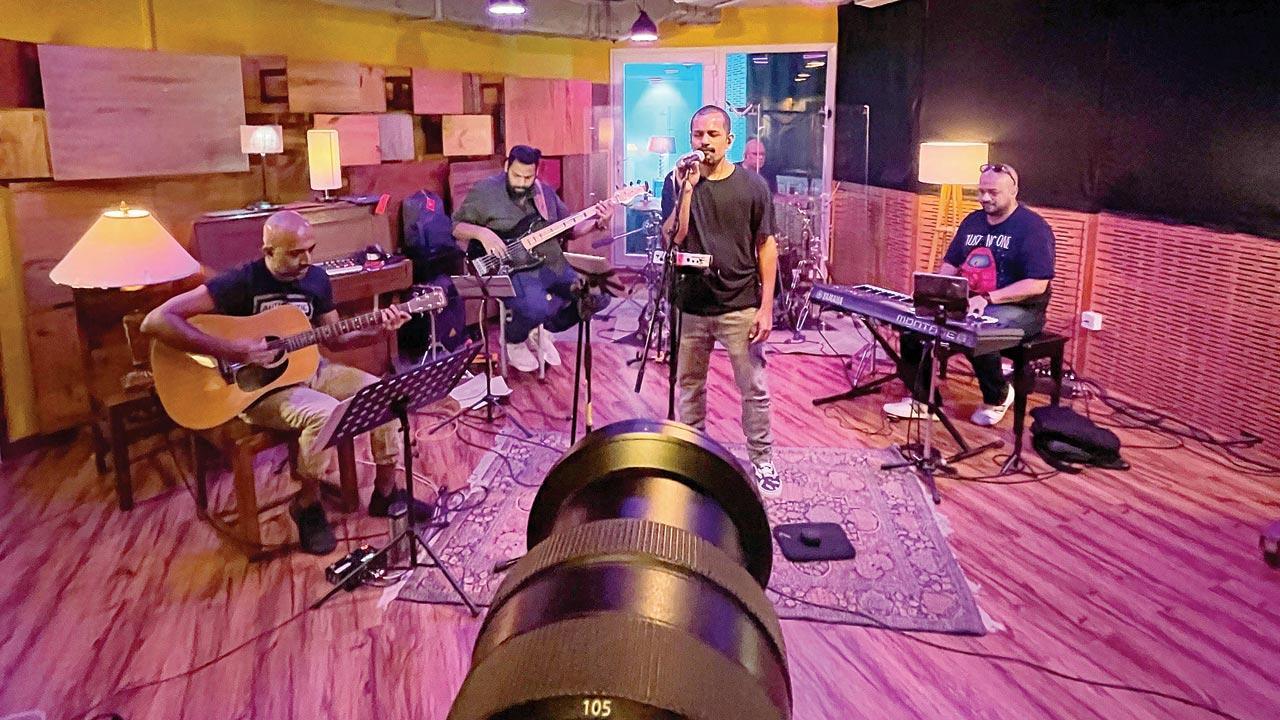The indie music industry underwent various pandemic-induced developments. We assess where these innovative steps lie one year down the line

The live-streams at Island City Studios are shot with DSLRs, not iPhones
When the knock-out punch of the pandemic was first dealt in March last year, Jehangir Jehangir felt the blow in full force. “We were like, ‘Oh sh*t, what are we going to do now?’” the co-founder of Khar’s Island City Studios recalls about those dark days of April and May 2020, adding that any initial hopes they had of the lockdown being fully lifted soon dissipated. So, he started picking up the pieces. “I spoke to a few people like Pradeep Mathews of Glassonion Studios and Aditya MC from Chennai, who had started a bunch of live-streaming concerts, and realised that that’s where the market lies right now.”
The people at Island City Studios’ control room are given walkie-talkies to communicate with those in the live room. Pic/Atul Kamble
The multi-instrumentalist and sound engineer’s assessment wasn’t wrong. Over the past year and a half, live virtual gigs have taken off within the Indian independent music space like never before. But it’s not just that. There have been other developments within the circuit — some innovations, even — that stakeholders have relied on to keep swimming against the tide. Indian audiences were introduced to online musical experiences with cinematic narratives, with a music event titled Unrated in August last year. Big-ticket festivals like NH7 Weekender and Sunburn went virtual. Indie musicians increasingly donned the hats of educators to keep their income from drying up, now that physical live gigs were indefinitely stalled. And tellingly, they took time off to up-skill their craft, and rallied around each other more than earlier, realising that they need to stay afloat together when they are all in the same boat.
Jehangir Jehangir, Soham Sarcar and Raghav Meattle
But where do these developments stand today? What worked and what didn’t? And which ones will stand the test of time, even when things get back to normal?
Small changes go a long way
Singer-songwriter Raghav Meattle, for one, feels that the future will see both virtual gigs and physical ones co-existing to a certain extent. He tells us, “The space is evolving over time and even when there are gigs on the ground later on, they will be live-streamed for a wider audience.” Jehangir, meanwhile, points out how they had to adapt over the course of last year and this one to improve the live set-up at Island City Studios. They did little things that added up to a lot. Overhead lights were set up so that the videos shot in the space didn’t have lamps with ugly stands. iPhones were replaced with DSLR cameras. The people working in the studio were given walkie-talkies so that there was constant communication between the live and control rooms. “But the best thing I did was to invest in an Atom Mini, a gadget that gives you four cameras and a companion app that allows a phone to indicate when the cameras have gone live,” he says.
Building new experiences
These low-investment, but key adjustments meant that music studios — places that were earlier used primarily for recording audio — became venues for artistes to explore the audio-visual medium of live gigs, without the quality being completely compromised. Of course, it can’t match up to the exhilaration of an offline gig, but the way things stand, it’s all that we have now. Yet, Soham Sarcar, founder of experimental events company Transhuman Collective that organised Unrated, an experiential music event, feels that there is a sense of ennui about virtual concerts that is setting in among the audience. “The truth is, people are getting bored, which is why you have fewer of them now,” he tells us. What Sarcar instead tried to do with Unrated is create a visual narrative set in outer space, which had a musical backdrop of DJs playing sets. “The main thing is that we didn’t try to replicate a physical environment. We wanted to create an entirely new experience for people,” he says.
Integrating everything together in terms of the lights, music and narrative was a technical challenge, though. But it’s been a learning experience, and Sarcar reveals that they are already in the planning process for Unrated 2.0 next year, which will be a bigger event with sponsors on board. It goes to show that the myriad people behind the various pandemic-induced developments in the music industry aren’t planning to dump their efforts altogether when things get back to normal.
Musicians who turned educators will keep teaching students. The sense of community built within the industry, born during the toughest of times, will not be forgotten soon. The live-streaming space will possibly fit hand-in-hand with physical performances, as Meattle says. And alternative music experiences with cinematic treatment might even be co-opted by OTT platforms, Sarcar believes, and if that does indeed happen, remember that you read it here first.
 Subscribe today by clicking the link and stay updated with the latest news!" Click here!
Subscribe today by clicking the link and stay updated with the latest news!" Click here!







